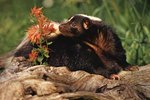
As a group, turtles consume a wide variety of foods, from grasses to fruits to other turtles. Generally speaking, most terrestrial tortoises are herbivores, while aquatic and semi-aquatic turtles are omnivorous or carnivorous. Many of the aquatic and semi-aquatic species will consume just about any other animal they can catch and overpower. Most often, the only limitation on the turtle's prey is size, and in the case of large turtles, rodents like rats and mice are opportunistically consumed.
Snapping Turtles
Snapping turtles (Chelydra serpentina) are large turtles native to most of the United States. Though explicit data regarding rodents in the stomachs of wild snapping turtles is scarce, snapping turtles are omnivores that are known to consume carrion. Rodents that die and fall into the water may be consumed, as may any live rodents that are careless at the water's edge. Captive snapping turtles are often fed mice or rats, though some captives seem put off by the fur.
Alligator Snapping Turtle
The alligator snapping turtle (Macroclemys temminckii) is the largest freshwater turtle in the world. Typically inhabiting deep water and seldom venturing on dry land, alligator snapping turtles will only rarely encounter rodents. Despite this, rodents form a key dietary component of alligator snapping turtles in zoos and museums around the world. As these turtles approach or exceed 150 pounds in weight, they are capable of easily ingesting full-grown rats.
Soft-Shell Turtles
Soft-shell turtles (Apalone sp.) can achieve very large sizes; females of some species reach up to 24 inches. Soft-shell turtles will actively pursue their prey, but often they bury themselves in the substrate and attempt to ambush animals that venture by. While sometimes fed rodents in captivity, soft-shell turtles don't often encounter rodents in the wild. It's possible that any rodents that die and fall into the water are consumed, as soft-shell turtles are known to scavenge for carrion.
Box Turtles
Box turtles (Terrapene sp.) are semi-aquatic turtles that range widely as they scavenge for food. Though fearsome predators of insects, worms and slugs, box turtles lack the speed and agility to catch live rodents. Despite this, box turtles and a number of similar species, like the Clemmys evolutionary lineage, are fed, and eagerly accept, pre-killed rodents in captivity. Wild box turtles will also consume any dead or newborn rodents that they encounter in the wild.
References
- Smithsonian National Zoological Park: Alligator Snapping Turtle
- Smithsonian National Zoological Park: Florida Softshelled Turtle
- Chelydra.org: Snapping Turtle Food and Feeding
- Tortoise.org: Captive Husbandry of the Eastern Clemmys Group at Zoo Atlanta
- Exoticpetvet.net: Nutrition of Turtles and Tortoises
- Chicagoherp.org: A Chelonian “Pear-able”: Observations on Frugivory and Herbivory in Common Snapping Turtles (Family Chelydridae: Chelydra serpentina)
- Boxturtlefacts.org: The North American Box Turtle Diet
Photo Credits
-
Jupiterimages/Photos.com/Getty Images




